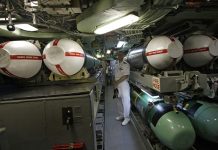General MM Naravane has made history by becoming India’s first Chief of Army Staff (COAS) to land in the United Arab Emirates (UAE) and the Kingdom of Saudi Arabia for official talks and deliberations that will accelerate the pace of military cooperation, both in quality and range, with the two countries.
Not India, Former ISI Chief Hints At UAE, Saudi Arabia Being The Biggest Threat To Pakistan
The Army chief is visiting the UAE from December 9 to 10. He will then travel to the Kingdom of Saudi Arabia for the second leg of his tour from December 13 to 14.
An Indian Army chief visiting these two countries would have raised many an eyebrow earlier, given the Pakistan Army’s traditional close involvement with them. Pakistan has trained their armies.
The first five Air chiefs of the UAE have been Pakistan Air Force officers. Since 1967, Pakistan has routinely provided military and air force trainers to Saudi Arabia. Thousands of Pakistani troops have been present in the royal kingdom, with some elite Pakistani commandoes guarding the royal family in Riyadh.
Pakistan has been richly compensated financially by these two Sheikhdoms for its military cooperation, but, of late, they are realizing that Pakistan is not trustworthy. Islamabad is seen to be at the forefront in creating an alternative bloc of Islamic countries led by Saudi Arabia’s traditional rival Turkey.
Saudi Arabia and the UAE deeply resent Pakistan’s wooing of Iran. Riyadh has also not forgotten how despite its liberal financial assistance to Islamabad, the latter did not keep its pledge to “protect Saudi territory” by refusing to allow Pakistani troops to join the Saudis in their war against Yemen.
The Erdogan Effect
Saudi Arabia and the UAE have noted with concern the “Erdogan-effect” on Pakistan in recent years. Ever since the Islamist-conservative Justice and Development Party (AKP) came to power in 2002, led by Recep Tayyip Erdogan, it has become more important to Pakistan in garnering support for its stance on Kashmir as well as defense cooperation.
Erdogan has visited Pakistan four times in official capacities. Pakistan has awarded the Agosta 90B Submarine Modernization Project, worth US$350 million (S$475.2 million), to STM, one of Turkey’s leading arms manufacturers.
In 2018, the Pakistan Navy commissioned Turkey a fleet tanker, which was built in collaboration with the STM in Karachi. Turkish Aerospace Industries (TAI) has signed a US$1.5 billion (S$2.04 billion) agreement to sell 30 T129 helicopter gunships to Pakistan; although it has not materialized following the US refusal to give the export license to Turkey as the engines do have the American components.
Turkey has also awarded a contract of 52 Super Mushshak trainers (aircraft) to the Pakistan Aeronautical Complex. The Super Mushshak is an upgraded variant of the Saab MFI-‐17.
On the other hand, while disenchantment of the UAE and Saudi Arabia with Pakistan has been growing, India’s Modi government has actively wooed these two countries, along with Oman, Bahrain, and Kuwait, all members of the Gulf Cooperation Council (GCC). Since first becoming Prime Minister in 2014, Narendra Modi has visited the GCC countries eight times, including thrice to the UAE and twice to Saudi Arabia. The only Gulf country the Indian Prime Minister has not visited so far is Kuwait.

Modi has been honored with the ‘Order of Zayed’, the UAE’s highest civilian award. In October last year, during his visit to Saudi Arabia, Strategic Partnership Council (SPC) was established between the two countries. India, thus, became the fourth country with which the Kingdom has formed a strategic partnership, the others being the UK, France, and China.
Pakistan’s Loss, India’s Gain
It may be noted here that as per its “Vision-2030” roadmap, India has been declared to be one of the eight strategic partners of Saudi Arabia. These are India, China, the UK, the US, France, Germany, South Korea, and Japan. Significantly missing from this list is Pakistan.
The Vision-2030 says, among others, Saudi plan to diversify the country’s economy for its sustainability. Although oil and gas are essential pillars of the Saudi economy, the government has begun expanding the country’s investments into additional sectors domestically and abroad.
#استثمر_الهند#الهند_الجديدة– تعمل على توسيع قدراتها في مجال الطاقة المتجددة وذلك من أجل توفير مستقبل نظيف ومراعٍ للبيئة!
للمزيد: https://t.co/1526f0FziB#استثمر_في_الهند @mnreindia pic.twitter.com/zsZzVzBhr8
— Invest India – GCC (استثمر في الهند – مجلس التعاو) (@InvestIndiaGCC) December 8, 2020
It wants better utilization of “Khaleeji” or Gulf capital than keeping it in Western banks (Khaleeji capitalism is a term coined by Adam Hanieh, a scholar based in London’s School of Oriental and African Studies). India, given its vast market, human resources, and sound legal system, is seen as an alternative destination.
In this, the military-spending is an important component. Although the Kingdom is the world’s third-biggest military spender, only 2 percent of this spending is within the Kingdom. Therefore, Saudi Arabia is keen on developing its defense-industrial sector, particularly less complex industries such as those providing spare parts, armored vehicles, and basic ammunition. And this they want to achieve through strategic partnerships, where India figures prominently.
India’s Defense Ties With Saudi, UAE
As of now, India and Saudi Arabia have formed a Joint Committee on Defence Cooperation (JCDC). Delegation-level visits have been taking place between the two armed forces since 2018. The two countries have already agreed for the training of officers from the Royal Saudi Armed Forces at Indian defense training institutes.
The two sides have also begun joint exercises between different branches of the military. They have “agreed to cooperate and collaborate in joint defense production of spare parts for naval and land systems as well as supply chain development.”
They are “working together with other Indian Ocean Rim Countries” to ensure security in the Indian Ocean and the Arabian Sea. The Indian Navy and Coast Guards hold regular interactions with their counterparts in Saudi Arabia. Indian naval ships often undertake port calls to Saudi Arabia.
Army Chief General MM Naravane to be on a visit to the UAE & Saudi Arabia from 9th to 14th Dec. He will meet his counterparts and senior military leadership of these countries. It will be the first time that an Indian Army Chief is visiting the UAE & Saudi Arabia.
(file photo) pic.twitter.com/uzbiZ8hjor
— ANI (@ANI) December 8, 2020
Similar defense cooperation and engagements are also visible between India and the UAE. The two countries now have a Joint Defence Cooperation Committee (JDCC). There are now regular joint exercises, exchanges of visits by military officials, and talks on cooperation in the area of defense manufacturing and space exploration.
Indian Navy and Coast Guard ships go on regular port calls to the UAE. In 2018, their navies conducted the first joint exercise, ‘Gulf Star I’ off the UAE coast. Their air forces have conducted joint exercises such as ‘Desert Eagle II’ at the Al-Dhafra Air Base in Abu Dhabi.
Both Saudi Arabia and the UAE have shown interest in Indian military products such as Akash surface-to-air missile, BrahMos anti-ship cruise missile. Saudi Arabia is keen to invest in India’s defense sector, particularly in munitions, small arms, shipbuilding, unmanned platforms, and armored vehicles.
The UAE and Saudi Arabia are also collaborating with India, in counterterrorism measures with better intelligence sharing and coordination between enforcing agencies. Viewed thus, General MM Naravane’s visit to these two countries is likely to further strengthen the above trends.
Authors Profile: https://eurasiantimes.com/author/tdeprakashnandaedt/
Email: prakash.nanda@hotmail.com
Follow EurAsian Times on Google News




